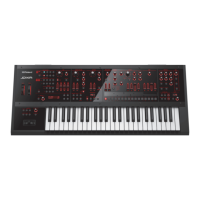59
Arpeggio
Using the Arpeggio Function
Turning Arpeggio On/O
1. Press [Arpeggio] to turn the arpeggio function on.
2. Hold down a chord on the keyboard.
3. To turn the arpeggio function o, press the [Arpeggio] button once again to make it go dark.
The Arpeggio Switch parameter of each part species which part(s) will play arpeggios.
& “Part Arpeggio Switch (Arp Sw)” (p. 3)
Making Settings for the Arpeggio Function
1. Hold down the [Shift] button and press the [Arpeggio] button.
2. Use the cursor buttons to select a parameter, and use the [-] [+] buttons to change the value.
Arp Hold: If this is on, the arpeggio continues playing even if you take your hand o the keyboard.
Using a pedal switch
If you hold down a pedal switch while playing a chord, the arpeggio continues playing even if you release the keyboard.
1. Connect your pedal switch (e.g., DP series; sold separately) to the HOLD jack.
2. Press the [ARPEGGIO] button.
3. Play a chord while holding down the pedal switch.
If you play a dierent chord or key while the arpeggio is being held, the arpeggio also changes.
Parameter
Cursor [
K
] [
J
]
Value
Value [-] [+]
Explanation
Grid
1/4, 1/8, 1/8L, 1/8H, 1/12,
1/16, 1/16L, 1/16H, 1/24
Species the time signature and swing of the arpeggio.
This determines the note value of one grid unit, and species the shue strength (none/light/heavy).
1/4: Quarter note (one grid unit =one beat)
1/8: Eighth note (two grid units = one beat)
1/8L: Eighth note, light shue (two grid units = one beat; light shue)
1/8H: Eighth note, heavy shue (two grid units = one beat; heavy shue)
1/12: Eighth note triplet (three grid units = one beat)
1/16: 16th note (four grid units = one beat)
1/16L: 16th note, light shue (four grid units = one beat; light shue)
1/16H: 16th note, heavy shue (four grid units = one beat; heavy shue)
1/24: 16th note triplet (six grid units = one beat)
Duration 30–120%, Full
Species the duration that each arpeggiated note is sounded.
This determines whether notes are played briey to produce a staccato feel, or lengthened to produce a tenuto feel.
30–120: For example if this is set to “30,” a note on the grid (or in the case of a note that is extended across multiple
grid units by a tie, the last tied note) will have a duration that is 30% of the note value specied by the Grid setting.
Full: Even if consecutive grid units are not connected by a tie, the note continues to sound until the same note is again
assigned to play.
Motif
& “Selecting the
upward/downward
variation (Motif)”
Species how notes are sounded if more keys are pressed than the number of notes specied by the arpeggio.
Refer to “Selecting the upward/downward variation (Motif)” (p. 60).
Velocity REAL, 1–127
Species the strength at which the arpeggiated notes are sounded.
REAL: The velocity depends on the strength at which you play each key.
1–127: The notes are sounded at the velocity you specify here, regardless of how strongly you play the keys.
Oct Range
(Octave Range)
-3–+3
Species the range across which the arpeggio’s pitch is shifted.
The pitch range is shifted in steps of an octave each cycle.
You can specify this separately for the upward direction and the downward direction (maximum ±3 octaves).
Accent 0–100
Species the strength of the arpeggio’s accents.
If this is set to “100,” dynamics are applied to the notes according to the velocities of the notes assigned to the
arpeggio. If this is set to “0,” all notes are sounded at the same strength.

